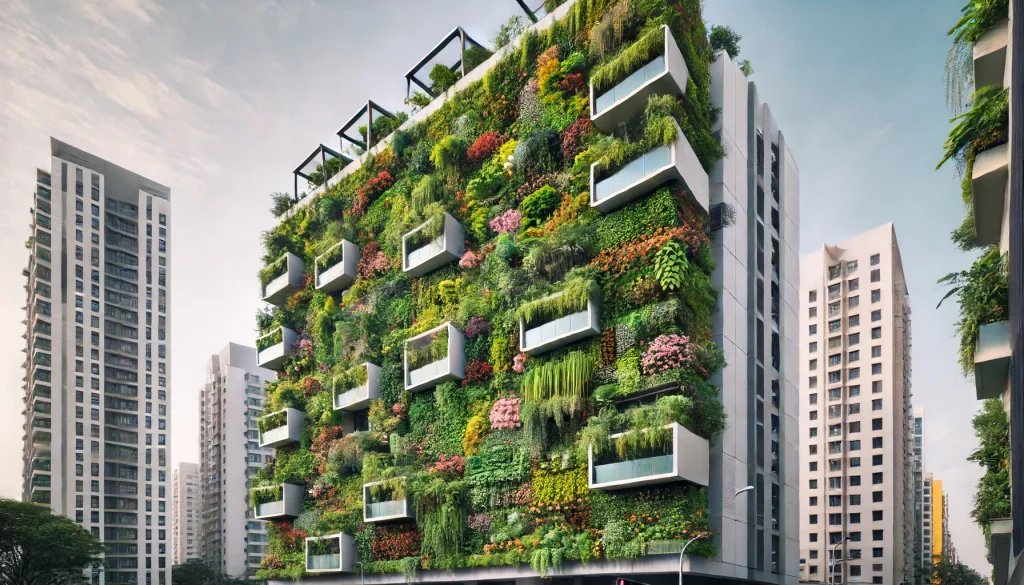

Vertical gardens, also known as living walls or green walls, are structures that allow plants to grow vertically rather than horizontally. These gardens can be installed on the exterior or interior walls of buildings, making them ideal for urban environments with limited space.
Vertical gardens consist of a support structure, a growing medium, irrigation systems, and the plants themselves. The support structure can be made of various materials such as metal, plastic, or wood. The growing medium, which can be soil, hydroponic materials, or a felt layer, provides the necessary nutrients for the plants. An integrated irrigation system ensures that the plants receive adequate water, often through a network of tubes and pumps.
These gardens offer numerous benefits, including improving air quality, providing insulation to buildings, reducing the urban heat island effect, and enhancing aesthetic appeal. They can also contribute to biodiversity by providing habitats for various species of plants, insects, and birds.
Overall, vertical gardens are an innovative solution to incorporate greenery into urban areas, promoting a healthier and more sustainable living environment. Below are some examples of how vertical gardens can become reality even for you.
- 1 Top Reasons to Invest in Vertical Gardens
- 1.1 1. Space-saving solution
- 1.2 2. Improved air quality
- 1.3 3. Noise reduction
- 1.4 4. Energy efficiency
- 1.5 5. Biodiversity
- 1.6 6. Aesthetic appeal
- 1.7 7. Food production
- 1.8 8. Stress reduction
- 1.9 9. Educational opportunities
- 1.10 10. Community building
- 1.11 What are Possible Obstacles?
- 1.12 Vertical Gardens Around The World
The Origins of Vertical Gardens
The concept of vertical gardens has roots that trace back to ancient civilizations. One of the earliest and most notable examples is the Hanging Gardens of Babylon, one of the Seven Wonders of the Ancient World, which featured terraced gardens growing vertically up the walls of the palace.
In modern times, the concept was revitalized and popularized by French botanist Patrick Blanc in the late 20th century. Blanc’s pioneering work in the 1980s and 1990s involved developing systems that allowed plants to grow on vertical surfaces without soil, using hydroponics and felt layers to provide nutrients and support. His innovative designs were first seen in his home country of France and later spread worldwide.
Blanc’s vertical gardens have been installed on various public and private buildings, showcasing their aesthetic and environmental benefits. His projects demonstrated how urban spaces could integrate greenery even when horizontal space was limited, leading to a resurgence of interest in vertical gardening techniques globally.
Today, vertical gardens are employed in urban planning and architecture worldwide, reflecting a blend of ancient inspiration and modern innovation in creating sustainable and visually appealing green spaces.
Top Reasons to Invest in Vertical Gardens

Vertical gardens are becoming increasingly popular in cities around the world, and for good reason. These innovative gardens not only add a touch of greenery to urban landscapes but also offer a host of other benefits. Here are 10 reasons why vertical gardens are a must in cities:
1. Space-saving solution
Vertical gardens are perfect for cities where space is at a premium. By growing plants vertically, you can make the most of limited space and turn even the smallest of areas into a lush oasis.
2. Improved air quality
Plants are natural air purifiers, absorbing pollutants and releasing oxygen. Vertical gardens help to improve air quality in cities by trapping harmful toxins and producing fresh, clean air.
3. Noise reduction
Plants have the ability to absorb sound, making vertical gardens an effective way to reduce noise pollution in urban environments. By creating a barrier of plants, you can block out unwanted noise and create a peaceful retreat.
4. Energy efficiency
Vertical gardens help to insulate buildings, reducing the need for heating and cooling. By providing a layer of natural insulation, these gardens can help to lower energy consumption and reduce utility bills.
5. Biodiversity
Vertical gardens provide a habitat for a variety of plants, insects, and birds, increasing biodiversity in urban areas. By creating a green haven in the midst of a concrete jungle, these gardens help to support local ecosystems.
6. Aesthetic appeal
Vertical gardens add a splash of color and texture to cityscapes, enhancing the visual appeal of buildings and public spaces. Whether lush and tropical or sleek and modern, these gardens can be customized to suit any aesthetic.
7. Food production
Vertical gardens are a great way to grow your own food, even in the heart of the city. By planting herbs, fruits, and vegetables vertically, you can enjoy fresh, organic produce right at home.
8. Stress reduction
Spending time in nature has been shown to reduce stress and improve mental health. Vertical gardens offer a natural escape from the hustle and bustle of city life, providing a peaceful retreat for relaxation and reflection.
9. Educational opportunities
Vertical gardens can be used as educational tools, teaching city dwellers about plant care, sustainability, and the environment. Schools, community centers, and public spaces can all benefit from the educational value of these gardens.
10. Community building
Vertical gardens have the power to bring people together, creating shared spaces for residents to enjoy and care for. By fostering a sense of community ownership and pride, these gardens can help to strengthen bonds between neighbors and create a sense of belonging.
In conclusion, vertical gardens are a versatile and valuable addition to any city, offering a wide range of benefits for both residents and the environment. Whether you’re looking to add a touch of greenery to your balcony or transform a barren wall into a thriving garden, vertical gardens are a must-have for urban spaces.
What are Possible Obstacles?


Installing vertical gardens comes with several obstacles that need to be addressed for successful implementation. These include:
- Structural Support: Vertical gardens require strong and stable structures to support the weight of the plants, growing medium, and irrigation systems. Ensuring that the wall or framework can bear this load is crucial.
- Irrigation and Drainage: Effective irrigation systems are essential to provide adequate water to the plants. Additionally, proper drainage must be installed to prevent water accumulation, which can cause damage to buildings and create mold or mildew issues.
- Cost: The initial installation of vertical gardens can be expensive due to the cost of materials, design, and labor. Ongoing maintenance expenses, such as water, nutrients, and plant care, also need to be considered.
- Maintenance: Vertical gardens require regular maintenance, including pruning, pest control, and replacing dead plants. Without proper care, the garden can deteriorate quickly.
- Plant Selection: Choosing the right plants that can thrive in vertical conditions and the specific environmental conditions (light, temperature, humidity) is challenging. Some plants may not adapt well to vertical growing.
- Building Regulations: Compliance with local building codes and regulations is necessary. This may include permissions for altering building facades or installing additional structures.
- Climate: The local climate can affect the success of a vertical garden. Extreme weather conditions, such as high winds, heavy rainfall, or intense sunlight, can damage plants and structures.
- Expertise: Installing and maintaining vertical gardens often requires specialized knowledge and skills. Finding professionals with the necessary expertise can be difficult.
- Longevity: Ensuring the long-term sustainability and health of the vertical garden requires continuous monitoring and adaptation, which can be resource-intensive.
Addressing these obstacles involves careful planning, design, and ongoing management to ensure that vertical gardens are both functional and sustainable.
Vertical Gardens Around The World
Vertical gardens have been successfully implemented in various locations around the world, showcasing their versatility and aesthetic appeal. Here are a few notable examples:
- One Central Park, Sydney, Australia: This residential building features one of the world’s tallest vertical gardens. Designed by French botanist Patrick Blanc and architect Jean Nouvel, the garden spans multiple stories and includes a variety of native and exotic plants, significantly enhancing the building’s sustainability and aesthetic appeal.
- Athenaeum Hotel, London, UK: The Athenaeum Hotel’s living wall, designed by Patrick Blanc, covers the entire exterior facade of the building. It features a mix of seasonal plants, providing year-round visual interest and improving the hotel’s environmental footprint.
- Museo del Acero Horno3, Monterrey, Mexico: The steel museum features a striking vertical garden designed by Patrick Blanc. This living wall enhances the museum’s industrial architecture, providing a lush, green contrast to the steel structures.
- CaixaForum, Madrid, Spain: Another project by Patrick Blanc, the CaixaForum’s vertical garden covers a large exterior wall of the cultural center. It features a diverse array of plants, creating a vibrant and visually appealing urban oasis.
- Changi Airport, Singapore: The Jewel Changi Airport features the “Rain Vortex,” the world’s tallest indoor waterfall, surrounded by a lush vertical garden. This green space provides a tranquil and refreshing environment for travelers, enhancing the overall airport experience.
- Green Wall at Quai Branly Museum, Paris, France: Designed by Patrick Blanc, this vertical garden covers the entire facade of the Quai Branly Museum. It includes over 15,000 plants from 150 different species, creating a stunning green tapestry that complements the museum’s mission of showcasing world cultures.
These examples demonstrate how vertical gardens can be successfully integrated into various types of buildings, from cultural institutions to residential complexes, enhancing both their environmental and aesthetic qualities.
